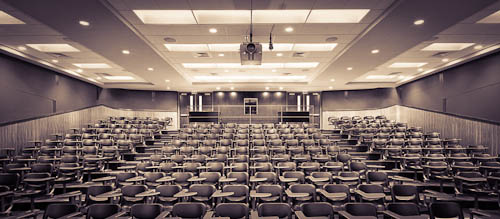Or: Intellectual Accessibility by Availability and Design
As a sociology graduate student, I sometimes feel like Simmel’s “stranger,” close enough to academia to observe, but distant enough to retain an outside perspective. Like many graduate students staring down a possible academic career-path, I’m a bit terrified at the elephant in the room: is what academics do really important? are they relevant? does it matter?
Who reads a sociology journal? As my former theory teacher Chet Meeks once posed to my first social theory course, how many people look to sociology journals to learn anything about anything? While the occasional sociologist is quoted in the New York Times or appears on CNN, the influence these experts have is vanishingly small. I do not know as much about other disciplines, but the point for most of the social sciences and humanities is that, in my opinion, expert knowledge is largely going to waste.
And to echo folks like Steven Sideman or danah boyd, we have an obligation to change this; academics have a responsibility to make their work relevant for the society they exist within.
The good news is that the tools to counter this deficiency in academic relevance are here for the taking. Now we need the culture of academia to catch up. Simply, to become more relevant academics need to make their ideas more accessible.
There are two different, yet equally important, ways in which academics need to make their ideas accessible:
(1) accessible by availability: ideas should not be locked behind paywalls
(2) accessible by design: ideas should be expressed in ways that are interesting, readable and engaging
To become publicly relevant, academics must make their ideas available to and articulated for the public.
I. Accessible by Availability
PJ Rey argued on this blog that journals and their articles are the “dinosaurs” of academia because “they wield enormous (and terrifying) power, yet they are ill-adapted to function in a changing environment.” Print, and even digital, articles are said to be vestigial organs of a different time.
Unlike PJ, I do think journal articles have a continuing and important role in intellectual discussions today and moving forward (a point Patricia Hill-Collins also made in reply to PJ’s piece). Not vestigial organs, journals remind me more of the process of exaptation, referring to the evolutionary process where something evolves in one environment for one purpose but comes to take on a new purpose in a different environment (feathers are the classic example of this co-optation). The five-to-ten-thousand-word well-researched, rigorously-argued, highly-edited, peer-reviewed and jargon-heavy format continues to have its place. Highly-technical arguments need to be hashed out. Even intellectual discussions that have no larger pragmatic purpose should be embraced for their own sake (in that same way we embrace art or sports). That “mental masturbation” is used as a pejorative has always confused me. More importantly, understandings that are best achieved in the article format can be translated into other formats (blogging, tweeting, giving talks and so on).
But PJ and I both agree that the academic journal system as it currently exists is fundamentally broken. Most prestigious journals are “closed,” locking articles down behind paywalls. This is one reason for academic irrelevancy.
First, there is the issue of print publishing. Typesetting, printing, binding and whatever else goes into making the print journal that is then shipped across the globe (using gasoline!) once made sense. These once were necessary costs to disseminate information widely. Because you are reading a blog you already know that the Web radically changes the dissemination of information. Journals with all the same rigorous peer-review and editorial standards can exist online at a fraction of the cost of print journals without letting articles wither away behind paywalls. Yesterday, print journals were created to facilitate the spread of information; today, the continued existence of print journals comes at a cost to the spread of information.
Printing, of course, is only part of the cost involved with maintaining a journal. Editorial work (both in managing the various authors as well as the articles themselves), web-server space as well as web design and maintenance are all costly. However, as many current open-access journals have proven, these costs can be mitigated while keeping articles free to access.
Here’s an idea: if University libraries paid for every penny it would take to run the current crop of prestigious journals across all disciplines as web-only-open-access and stopped buying them from publishers those libraries would save a massive amount of money and all the articles could be available to all. This would save tax-payer and undergrad-tuition dollars and make academic research more available and therefore more relevant. Even if it would cost $100,000/year to operate, say, the American Journal of Sociology as web-only and open-access, this could be paid for with a tiny fraction of the money libraries are collectively paying the The University of Chicago Press for this journal now.
But this is only half of the availability fight. While top-tier journals should be made open access, open-access journals should also be made top-tier. Danah boyd wrote a terrific post covering much of this ground back in 2008, asking academics to boycott closed journals. She has also curated a good list of open-access publications. To second her call, academics need to prioritize reviewing for, citing from and publishing in open-access journals. Academics in positions of power need to consider intellectual availability in hiring and tenure decisions. Did this particular candidate attempt to make their ideas available for the public or did they participate in locking their ideas behind paywalls?
II. Accessible by Design
I can get everything I wished for above–i.e., a world where articles that are available free to everyone that have not been printed and shipped are considered as legitimate by academics in power–and this would only be one small, but important, step in expanded public relevance for academics. The other half of the battle is for academics to express their insights, data and solutions in ways that are accessible.
The Internet disrupts the music, film, news, porn and other industries because of high demand for the content. If I snapped my fingers and the American Journal of Sociology was completely open-access there probably would not be a massive rush of people scrambling to start downloading articles. As a fan of thinkers like Adorno or Hofstadter, I should confess that my first reaction is to scoff at the anti-intellectual nature of mass culture. But that would be short-sighted; there is popular demand for cutting-edge ideas, new data and smart solutions. But academics have, by and large, done a poor job expressing themselves to the public.
As I said above, there should be space for highly intellectual, jargon-heavy debates where interested parties can have fun nerding-out over some super-technical detail of an obscure theory. However, academic conversations usually revolve around issues of larger importance (as obscure as they sometimes sound). Thus, research should (also) be written in a way the public wants to consume it.
Journal articles, especially those in open-access publications, can be written in a way that those outside of one’s discipline can understand. This is especially crucial if one wants journalists to report on the findings. Perhaps more importantly, academics need to think beyond the journal article: blogging, tweeting, and writing in newspapers, newsmagazines, news websites, etc. all allow academics to reach larger publics.
And, of course, writing for larger public outlets means writing differently than academics are often trained to do.
I understand that not every academic may have the skills to write their research in a way that is interesting to the public in general. It is sad that this skill is not included in academic training. Making complicated topics, ideas and research easy to understand and egaging is an under-valued and difficult task. Here, perhaps we can lean on journalists. Recruit them to cover your work. Most of them value and have learned to communicate to the wider public.
*********
To conclude, academics have a responsibility to make sure their insights, research and solutions are publicly relevant. And the current irrelevancy crisis academia is suffering is not just the fault of an anti-intellectual news system or general public, but is also because academic work is simply not accessible. It’s not accessible because the work is not available when locked behind excessive pay-walls, and it is not accessible because few would want to read the work even if it was free.
Thus, the attack is two-pronged: (1) accessibility by availability: we have to make top-tier journals open-access and open-access journals top-tier; (2) accessibility by design: write research in blogs, tweets, open-access journals, op-ed’s, whatever, in ways that are readable, understandable, fun and relevant to larger publics.
Follow Nathan on Twitter: @nathanjurgenson
How academics can become relevant summary list
- make prestigious journals open-access
- make open-access journals prestigious (publish in them, cite them, consider them in hiring/tenure decisions)
- blog about your research
- tweet
- write for popular outlets like newspapers, newsmagazines, news websites, etc
- explain your research to journalists
- write in a readable way (explain why your research is important; make it entertaining/engaging; design is important, use good images, slick website, etc)




Comments 15
Sascha — January 23, 2012
One of the few times I can't say more than: Exactly! It's a shame that nobody cares about academia! Everybody who's writing a paper should remember your summary list.
Thomas Wendt — January 23, 2012
I run into this problem all the time. As someone heavily invested in academic research but not affiliated with a University, it's extremely difficult to obtain materials, even form public libraries. While I understand the economic need to charge for certain material, it essentially locks the potential of knowledge behind the Ivory Tower walls and prevents independent research. Of course, while independent research is possible and many do it very successfully, the paywall creates a hierarchy among academic and non-academic research. The perception is that non-academic research is sub-par because it is A) not recognized as part of the academic system, and B) not as thoroughly researched as something that results from access to university libraries.
I would love to see more academics blogging or releasing papers on free sites. Professors currently build a reputation by publishing and speaking. Why not extend that to the social web? Build reputation by exposing a much wider audience to your work.
PJ Patella-Rey — January 25, 2012
I very much like the way you discuss "exaptation" and journals, though I think my position is somewhat mis-characterized here. I absolutely believe that rigorous, long-form writing is fundamental to academic research; however, this fact does not render the journal article or its traditional modes of distribution immune from critique. As I say in the comments of my original post:
It's not just that individual academics fail in aspiring to make their work available and comprehensible but that the entire academic system fails to incentivize (and, in fact, disincentivizes) these practices in hiring. I get into greater detail on this issue it my recent GMU presentation "Academic Marginalization in the Age of Social Media."
Laura Norén — January 30, 2012
Along the lines of "every little bit helps" I would argue that one baby-step on the way to making the entire contents of the academic journal system freely available online would be for the journal publishers to release portions of articles from copyright protections. In particular, I'm thinking about the figures, charts, graphs, and photographs that go along with the articles. In order to do a good job of representing work on a blog, it's often quite useful to have the charts/graphs/diagrams and other supporting images that accompanied the original article.
While it is possible to paraphrase one's research argument in a blog using different words and thus convince the journal publishers that this blog is promoting, not infringing on the copyright, of the full article, it is much harder to paraphrase a graphic, diagram, chart, photo, or other figure. These types of images are usually included because they are concisely summarize theoretical frameworks or findings that would make unwieldy, potentially unclear prose. Bulky, vague prose tends to bore and confuse broader audiences (heck, bulky prose bores and confuses the core audience half the time, too) so it's critical to allow the images, diagrams, and other visual content to move through pores in the paywall without incurring the wrath of legal penalty.
doug hartmann — January 30, 2012
great stuff here nathan. the kind of ideas chris (uggen) and i thought about all the time in editing Contexts. indeed, we've got similar goals but a new format and possibilities here with The Society Pages. so, so glad you are involved and speaking out, and getting others to chime in.
How Academics Can Become Relevant « n a t h a n j u r g e n s o n — February 13, 2012
[...] This was originally posted at Cyborgology – click here to view the original post and to read/write... [...]
The Unabomber Was Only Half Right » Cyborgology — February 24, 2012
[...] has been out for over a year, but Kevin Kelly’s What Technology Wants complicates this blog’s ongoing discussion of public intellectuals and the translation of social theory into popular press books. Kelly claims to have read “every [...]
Technoscience As Activism Conference » Cyborgology — February 29, 2012
[...] successful in shaping society’s relationship to science and technology. Where are academics? Where are all of the public intellectuals? While I acknowledge that specialists need a place to exchange ideas amongst themselves, there are [...]
Cyborgology Turns Two » Cyborgology — October 26, 2012
[...] want to highlight here is the one that first sprang to mind when thinking back over the past year: How Academics Can Become Relevant. In the piece, I discuss what I don’t like about academia, but, mostly, it is a personal [...]
The Post-Racist Debate | Queer Metropolis — February 20, 2013
[...] should blog, Jurgenson from Cyborgology tells us, to engage with those outside of the [...]
Conditionally Accepted | Blogging For (A) Change — February 4, 2014
[…] traditional academic writing. Also, it presents a medium to transcend the traditional barriers to making academic work accessible. Earlier this year, I wrote an essay, “Blogging For (A) Change,” about using blogging […]
Academic Blogging, a Personal Experience | Freakonometrics — February 20, 2014
[…] Jurgenson, N. (2012, 01 23). How Academics Can Become Relevant. 02 01, 2014, http://thesocietypages.org/cyborgology/2012/01/23/how-academics-can-become-relevant/ Kaufman, S. (2007, 11 1). An Enthusiast’s View of Academic Blogs. 02 01, 2014, […]
Blogging Accademico, un’esperienza personale (parte seconda) | Leggere, scrivere e far di conto — July 5, 2014
[…] Jurgenson, N. (2012, 01 23). How Academics Can Become Relevant. 02 01, 2014, http://thesocietypages.org/cyborgology/2012/01/23/how-academics-can-become-relevant/ Kaufman, S. (2007, 11 1). An Enthusiast’s View of Academic Blogs. 02 01, […]